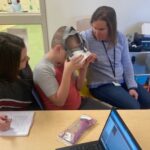As schools opened their doors this fall, one of the biggest challenges on school leaders’ minds: filling teaching vacancies and addressing teacher shortages.
School districts nationwide are facing unprecedented teacher shortages, with thousands of classrooms unstaffed as the school year begins. Filling these vacancies with certified teachers is a critical need.
With no end in sight to this teacher crisis, some districts across the country are filling instructional gaps utilizing non-traditional teaching and learning models.
In this eSchool News webinar, you’ll hear how districts are working on innovative solutions education leaders can put into place for a single class, school, or the entire district to launch this school year with a fully qualified and certified instructional team.
Experts will discuss:
- Filling vacancies immediately with certified remote teachers for a single class, school, or the entire districts
- Filling critical instructional gaps, expanding course offerings, personalizing learning, or reducing class size with blended or fully online programs
- Empowering learners with tools and resources necessary for high quality education
Related:
Is there a national teacher shortage?
How to solve the teacher shortage remotely
- New group targets AI skills in education and the workforce - May 6, 2024
- Friday 5: Teacher stress - May 3, 2024
- Student success is impacted by issues outside of school, survey finds - May 1, 2024
More from eSchool News
New group targets AI skills in education and the workforce
A new commission comprising policymakers, education leaders, business leaders, and education stakeholders from 16 states is tackling AI’s role in education from kindergarten through postsecondary programs.
Moving beyond transparency to accessibility and awareness
In one of my graduate courses for future PK-12 educational leaders, students are asked to review a student handbook and provide their recommendations on how to improve those handbooks.
Student-centered everything: ClassVR in special education
Spaulding Academy & Family Services is a small, non-profit special education school and residential facility serving students with a wide range of abilities, including many who are on the autism spectrum.
Friday 5: Teacher stress
Educators have never had an easy job, but teacher stress and burnout are at chart-topping levels in schools across the nation.
Embracing tech and navigating change with people-centered leadership
How can leaders navigate evolving opportunities and challenges and drive positive impact, while keeping the interests of students and educators at the forefront?
Smarter Classrooms for Today and Tomorrow
In the ever-evolving landscape of education, technology can play a pivotal role in shaping the learning experience.
Student success is impacted by issues outside of school, survey finds
Educators believe the biggest obstacles to student success in school are tied to challenges outside the classroom, including mental health and behavior issues, according to a new report from McGraw Hill.
5 digital resources to inspire curiosity and engage students
Post-pandemic, educators in my district report that there has been a decline in student engagement. As educators, it is incumbent upon us to spark student’s curiosity so that they will engage with instruction.
Critical steps to help school districts combat ransomware attacks
School districts are one of the most vulnerable industries for a ransomware attack, particularly from foreign adversaries, according to Ann Neuberger, deputy national security adviser for cyber and emerging technology.
Empowering girls with STEM education to build tomorrow’s tech industry
All too often, female students are underrepresented in STEM classes. As a result, girls and young women have a hard time exploring the subjects and picturing themselves in related roles.










